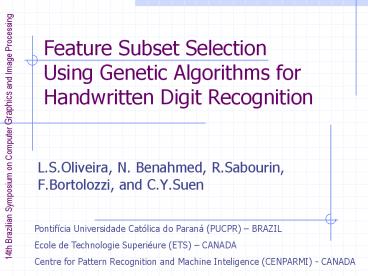Feature Subset Selection Using Genetic Algorithms for Handwritten Digit Recognition - PowerPoint PPT Presentation
1 / 15
Title:
Feature Subset Selection Using Genetic Algorithms for Handwritten Digit Recognition
Description:
14th Brazilian Symposium on Computer Graphics and Image Processing ... 14th Brazilian Symposium on Computer Graphics and Image Processing. Feature Set and Classifier ... – PowerPoint PPT presentation
Number of Views:972
Avg rating:3.0/5.0
Title: Feature Subset Selection Using Genetic Algorithms for Handwritten Digit Recognition
1
Feature Subset Selection Using Genetic Algorithms
for Handwritten Digit Recognition
- L.S.Oliveira, N. Benahmed, R.Sabourin,
F.Bortolozzi, and C.Y.Suen
Pontifícia Universidade Católica do Paraná
(PUCPR) BRAZIL Ecole de Technologie Superiéure
(ETS) CANADA Centre for Pattern Recognition and
Machine Inteligence (CENPARMI) - CANADA
2
Introduction
- Features can distinguish one class of patterns
from another in a more concise and meaningful. - It is not unusual to find problems involving
hundreds features. - Beyond a certain point, the inclusion of
additional features leads to a worse rather than
better performance. - Feature subset selection problem.
3
Feature Subset Selection
- Reduce the number of features used in
classification while maintaining an acceptable
classification accuracy. - Filter approach.
- Feature selection is done independently of the
learning algorithm used to build the classifier. - Wrapper approach.
- Takes into account the learning algorithm.
4
Feature Set and Classifier
- Feature set
- Based on a mixture of concavity and contour-based
features (132 components). - Classifier
- Neural network trained with BP algorithm.
- Database (NIST SD19).
- 195,000, 60,089 and 58,646 images for training,
validation and test respectively. - Performance.
- 99.13 validation set (hsf_7).
- 97.52 test set (hsf_4).
5
Genetic Algorithms for Feature Subset Selection.
- Practical applications such as handwriting
recognition presents a multi-criterion
optimization problem - Number of features.
- Accuracy of classification.
- Genetic algorithms (GA)
- Quite effective for rapid global search of large,
non-linear and poorly understood spaces. - Effective in solving large-scale problems.
- Simple GA and Iterative GA.
6
Genetic Algorithm
- Model of machine learning.
- Behavior derived from metaphor of some of the
mechanisms of evolution in nature. - Population based.
- Quality of each individual is evaluated through a
fitness function. - Main operators
- Selection, crossover and mutation.
7
Genetic Algorithm
Procedure Begin t ? 0 initialize P(t) while
(not termination condition) t ? t 1 select
P(t) from P(t-1) crossover P(t) mutate
P(t) evaluate P(t) end end
8
Representation and Operators
- Binary representation, which is the most
straightforward scheme. - Operators.
- Bit-flip mutation.
- One-point crossover.
- Roulette wheel selection.
9
Parameters
- Parameter settings.
- Population size 30.
- Number of generations 1000.
- Probability of crossover 0.8.
- Probability of mutation 0.007.
- Based on results of several preliminary runs.
10
Objective Function
- Two objectives
- Minimization of the number of features.
- Minimization of the error rate of the classifier.
- There is a set of alternative trade-offs.
- Weighting method.
- Aggregates the objectives into a single and
parameterized objective. - Linear combination.
11
Fitness Evaluation
- Wrapper approach.
- Evaluation of each chromosome requires training
the corresponding neural net and computing its
accuracy. - It is not feasible due to the limits imposed by
the learning time of huge database. - Sensitivity analysis.
- It uses the sensitivity of the net to estimate
the relationship of input features with the
network performance. - Replace the unselected features by the average
value computed in the training set.
12
Different Approach of GA
- Simple GA.
- Iterative GA.
- Speed up the convergence time of the algorithm by
restricting the search space. - Main difference search mechanism.
13
Iterative GA
14
Experimental Results
15
Conclusion and Future Works
- Two different approaches of GA for feature subset
selection. - Modified wrapper approach.
- Sensitivity analysis.
- SGA.
- Provide a reduction of about 30.
- Error rates in the same level.
- Multi-objective optimization.
- Pareto-based approaches.

